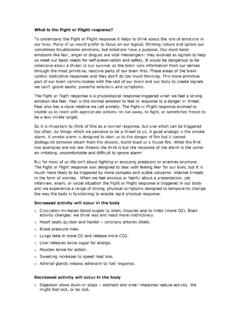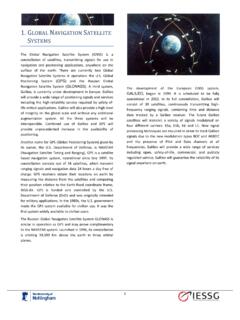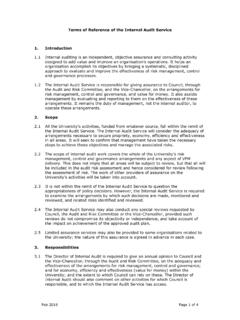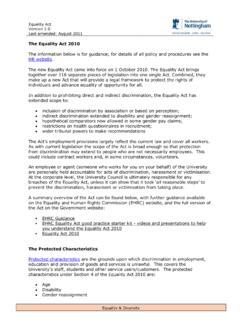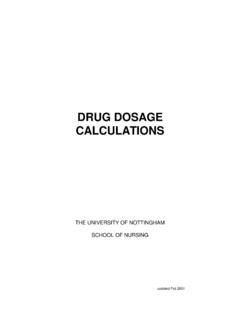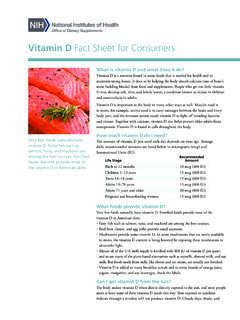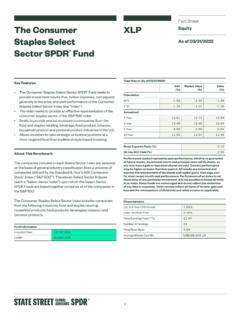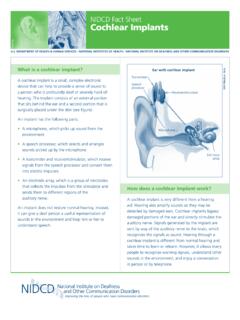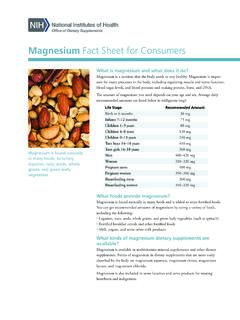Transcription of Fact Sheet: Alternative Protein - University of Nottingham
1 fact sheet : Alternative Protein This fact sheet will tell you more about Alternative Protein , its food sources, supply, regulations and food product applications. What is Alternative Protein ? Alternative Protein , such as plant-based meat substitute, or edible insects, provides a substantial amount of Protein , but requires less natural inputs ( water) to produce, compared to the most common and conventional Protein sources ( meat and fish). They are also called novel food proteins and are composed of different sequences of amino acids, which are responsible for building lean body tissues and human health.
2 Why is Alternative Protein of interest? Globally, an increasing demand for animal Protein is driving up livestock production, which leads to key issues of increased greenhouse gas emissions (GHG) (associated with our climate change) and increasing pressure on land and water usage, which leads to resource scarcity. It also has a high demand on animal feed, which is again, resource heavy. Red meat consumption is claimed to have links to health issues, such as cancer. However, Alternative Protein sources, such as plant-based, microbial-based and edible insects, are eco-friendly Protein sources, offering potential solutions to the global problem of food shortage, over-farming and depletion of natural resources.
3 In addition, the use of sustainable proteins has other advantages, such as improving public health/wellbeing (plant Protein sources); more ethical conscience (animal welfare) and religious considerations, thus potentially opening up new market/business opportunities for SMEs. It is important to note that a race for Alternative proteins could cause its own problems, unless we achieve a balanced response (both in nutritional balance and ingredients supply), the solution should be a mix of different Protein sources. Alternative Protein sources and options for food business New Protein sources/types/category 1st G* Animal based Conventional meat: Pork, beef, lamb, poultry etc.
4 2nd G Plant based Pulses/legumes; Seeds; cereals; Seaweed. Pea, soy, chia seed etc. 3rd G Insect based Mealworms, Crickets, locust/grasshopper 3rd G Microbial based Algae Protein ; yeast; mycoprotein 4th G Lab-grown meat In vitro cultured meat cells *G=Generation Current Alternative Protein market and consumption Based on Mintel market analysis, there are an increasing number of consumers that are going to be vegetarian/vegan/flexitarian in the near future. The biggest market driver for Alternative Protein sources is increasing health concerns among consumers, including sport enthusiasts and health addicts.
5 The four biggest drivers of Protein consumption among UK consumers listed by Mintel are muscle building, muscle maintenance, weight loss, and weight maintenance, accounting for 33%, 36%, 42% and 47% respectively. The demand for Alternative Protein sources is also seen to be on the rise globally, with the total market size forecasted by Allied Market research to reach 4bn by 2020. Europe accounts for almost 40% of the overall market revenue, due to the increase in the consumption of high Protein product ( snacks and sport nutrition) from meat alternatives. Options and opportunities for food applications Plant based Protein Benefits: Eco-friendly, more sustainable, nutritious and healthy and more affordability.
6 Protein content: generally ranges from 10-20%. Options: Soybean, Pea Protein , Rice Protein , hemp seed, chia seed, sacha inchi, plant Protein hydrolysates etc. food applications: Plant based Protein sources can be used in the forms of whole seeds, powder/flour, and Protein isolates/extracts. The different types of plant Protein sources could have different applications in foods, dependent upon their specific properties, contents and fractions. For example, pea Protein , as an ingredient is currently used in baked products ( cookies, breads/pizza base, and cakes) and extruded snacks.
7 Soybeans or soy Protein applications in food include meat extenders ( Beef, pork, poultry), meat analogues (meat replacement) and sport nutrition (dairy Protein replacement in Protein bars). Rice Protein is widely used in infant formula, soft drinks and sport nutrition. Insect based Protein Benefits: The benefits of using insects as human foods or animal feeds are similar to that for plant based Protein . The price can be more expensive due to less availability, but they can be more nutritious (high in Protein , unsaturated fatty acids, minerals and Vitamin B).
8 Protein content: up to 60-77% (dry matter) depends on the specific species. Options: To date, more than 2000 insect species have been identified as edible. However, the most common used insects for food applications now are crickets, mealworms, locusts and grasshoppers, termites and beetles. food applications: For SMEs, Insect Protein can be used as raw/whole insect, coated (Bars, Candy, Chocolate, Cookies, Snacks Packs and others), powder/flour form and paste form. In Asia, most insects are cleaned, cooked/fried with seasonings and then served as a whole insects; while in the EU/UK, most insects are processed (milled) into flour, which is then further used for food product formulation ( EatGrub fruit-flavoured insect based chocolate bars) in order to increase consumers acceptance.
9 Currently, insects are normally used in bakery, chocolate bars, muffins, biscuits etc. Microbial based Protein Introduction: Microbial Protein is the Protein derived from the dried cells of microorganisms ( yeasts, microalgae and fungi) grown in a large-scale culture system. Benefits: The benefits of using microbial Protein are similar to those stated above. It increases the diversity of Protein cosurces for consumers options. Protein content: ranges from 40-60% (dry matter). Options: The most common sources that can be used for food business are microalgae and mycoprotein ( derived from mushroom).
10 food applications: For example, the most successful business of mycoprotein application is the Quorn Brand (as ingredients in various Quorn products such as Quorn sausage). Some microalgae are also used to dress up beverages ( shakes and smoothies). Lab-grown meat Lab-grown meat, also called in vitro meat or cultured meat cells, is grown in laboratories through tissue engineering technology ( incubating a single muscle cell of beef or pig in nutrient rich liquid). Lab-grown meat has advantages of environmental and health benefits, reduced risk of contamination and foodborne illness, as well as being more ethically acceptable.


